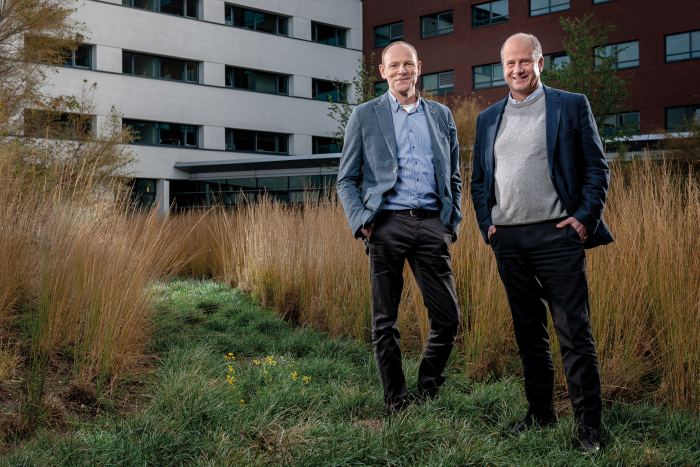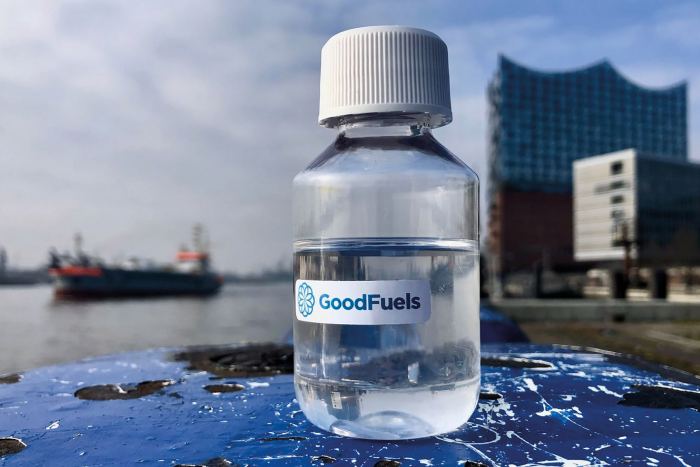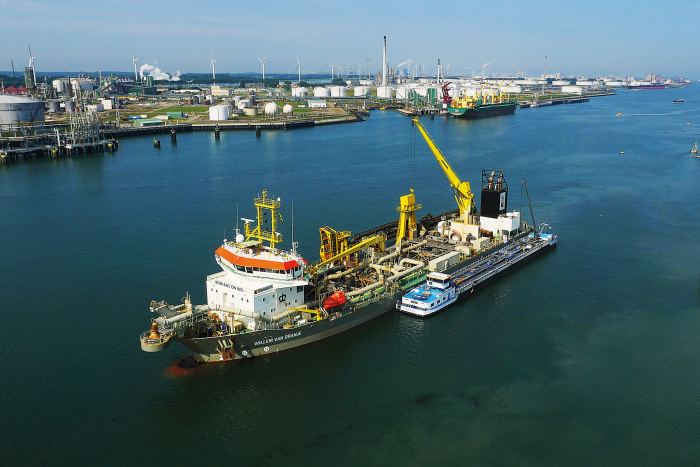Reducing emissions is very much on the agenda at Boskalis: with a large global fleet, the company is constantly looking to cut carbon emissions. Biofuels offer an economically viable and sustainable alternative to fossil fuels. Joost Wijnands, Manager Fleet Development and Joost Rijnsdorp, General Manager Corporate Procurement & Logistics, tell us why.
When did Boskalis start exploring alternative fuels?
Joost Rijnsdorp (JR): “We started looking at alternative fuels such as biofuels more than a decade ago. Two Dutch companies - KLM and Argos - launched a joint venture named ‘SkyNRG’ to develop drop-in biofuels for the aviation sector, originally using cooking oil. In 2014, we joined this initiative and started using diluted cooking oil fuel for our sand dumping trucks. However, we really wanted something specifically for our floating equipment and discussions started in 2015 about how to develop a truly sustainable drop-in biofuel for the marine industry that would be scalable and reliable, and reduce emissions substantially.”
“Boskalis Nederland aims to reduce the carbon emissions from its fleet and equipment by 35% in the next five years. The use of biofuels, alongside technical innovations and changes in human behavior, is key to achieving that ambition. Various sea trials conducted by Boskalis have shown that sustainable biofuels lead to an impressive reduction in carbon emissions: up to 90% compared with fossil fuels.”

Joost Wijnands (left) and Joost Rijnsdorp (right)
DISCUSSIONS STARTED IN 2015 ABOUT HOW TO DEVELOP A TRULY SUSTAINABLE DROP-IN BIOFUEL FOR THE MARINE INDUSTRY.
Boskalis entered into a partnership with GoodFuels. Can you tell us more about this cooperation?
JR: “Boskalis and biofuel supplier GoodFuels established a partnership to further develop sustainable practices at Boskalis. We worked closely with GoodFuels Marine and engine manufacturer Wärtsilä to launch a two-year biofuel pilot program that later developed into a strategic partnership. With the biofuel supplier GoodFuels, Boskalis as the shipowner and Wärtsilä as a major engine manufacturer, the combination is ideal.”
“When we originally started working with GoodFuels, we saw the potential of advanced biofuels for the shipping industry. But the ‘Boskalis on Bio program’ in partnership with GoodFuels and Wärtsilä has enabled us to make an essential contribution to the creation of the first global market for advanced biofuels for the marine industry. Some of our competitors are now using biofuel and we certainly expect the number of ship operators using biofuel to grow.”
What benefits do biofuels bring?
Joost Wijnands (JW): “We want our fuels to be both sustainable and affordable. Initially, we focused on light fuels only. But we believe that ‘drop-in’ biofuels are the way forward for the maritime sector. We are aiming to use a diesel blend consisting of 30% biofuels and even a blend consisting of up to100% biofuels in the near future. Drop-in biofuels can be used without any modifications to the engine or auxiliary systems. And drop-in biofuels are flexible: Boskalis can bunker them when they are available.”
“We thought biofuel had a lot of potential as a marine fuel but we were also quite critical. At the time, there was a lot of debate about additives in biofuels so we wanted to make sure this wouldn’t be an issue. Wärtsilä tested a range of new biofuels at its head laboratory in Finland starting in late 2015 and we were impressed by the tests of engine performance. The final results arrived in April 2016: particle emissions were substantially lower and the sulfur content was zero.”

Does biofuel production compete with food supplies?
JW: “For Boskalis, it is important that the biofuels from GoodFuels are made out of pure, sustainable residual flows that do not compete with the food chain or result in the deforestation of rainforests. We are adamant that biofuels should have no impact on the food supply chain. Palm oil production, for example, sometimes has a negative effect.”
“There are plenty of waste streams, from grass and algae to tires, that can be used as sources. In our case, we are using a biofuel made from paper residue. We are now using a drop-in biofuel in the Netherlands and around the North Sea, and in Singapore, where it is readily available. But we expect that it will become more easily available, particularly in view of the continuing push to reduce emissions and because clients are starting to include a biofuel requirement in their tenders.”
WE BELIEVE THAT ‘DROP-IN’ BIOFUELS ARE THE WAY FORWARD FOR THE MARITIME SECTOR.
Can you outline some of the latest projects using biofuels?
JR: “On the Marker Wadden project in 2016 in the Netherlands our cutter suction dredger Edax dredged for six months using a 50% biofuel blend consisting of residual products from the paper industry. This resulted in a huge reduction in carbon emissions. Boskalis Nederland now uses this fuel for some of its vessels, dry earthmoving equipment and trucks. And we have also used a blend of diluted cooking oil in the past to power the trailing suction hopper dredger Willem van Oranje in a pilot project.”
Did Boskalis also use a biofuel blend when installing the export cable for the Borssele offshore wind farm, making this renewable energy project even more sustainable?
JR: “The Borssele Alpha project is being executed on behalf of TenneT and it will connect the Borssele offshore grid to the Dutch high-voltage grid. During this project, several Boskalis vessels - including the jumbo trailing suction hopper dredger Prins der Nederlanden and our cable-laying vessel Ndurance - are operating with a blend consisting of up to 30% biofuels.”
“The client, TenneT, welcomed this step by Boskalis. We expect other clients to take this approach as they look to reduce their environmental footprint.”
FOR BOSKALIS, IT IS IMPORTANT THAT THE BIOFUELS FROM GOODFUELS ARE MADE OUT OF PURE, SUSTAINABLE RESIDUAL FLOWS THAT DO NOT COMPETE WITH THE FOOD CHAIN OR RESULT IN THE DEFORESTATION OF RAINFORESTS
Is Boskalis also considering the use of other alternative fuels such as LNG?
JW: “Boskalis has conducted studies of LNG. It is an interesting option but we feel that it may well be a ‘temporary fuel’ in the end because it is still not clean enough to fulfil the Paris Climate Agreement goals for carbon emissions. Even so, depending on the activities and operating profile of the vessel, LNG can be a useful option. In April this year, our joint venture Keppel Smit Towage launched its first LNG dual-fuel harbor tug in the port of Singapore. We also see a role for LNG in the towage and harbor industry. Of course, bunkering has to be convenient, like it is in ports like Singapore and Rotterdam.”
“In Singapore, the LNG fuel is carried in containerized, type-C ISO-certified tanks on the main deck, and refueling is possible with truck-to-ship operations or by replacing the empty tanks with full ones. The tanks are fitted with an innovative and patented LNG vaporizer which is compact and cost-effective.”JR: “In the case of dredging, however, the use of LNG is much more challenging. They often say ‘dredging starts where the world ends’. So it is frequently not possible to use alternative fuels like LNG at these remote locations.”

Bunkering of the trailing suction hopper dredger Willem van Oranje with biofuels
JW: “We reconsidered LNG in recent years when the main focus was on NOx and SOx reduction. LNG was the go-to fuel but it doesn’t go far enough: dual-fuel engines still emit methane (which is also a greenhouse gas) and the total reduction in carbon emissions is about 10-15%. This falls way short of what is needed to achieve the Paris goals. Even so, bio-LNG may be interesting!”
How about other alternatives such as methanol, ammonia and gas-to-liquids (GTL) technology?
JW: “We are considering all of them, and also alternative power sources like gas turbines and fuel cells, and we are involved in several studies and research groups. There is a lot of debate about alternatives involving electricity. For instance, when offshore wind farms produce too much electricity, can this energy be used to produce hydrogen and then stored? Fuel cells could then supply the power instead of the auxiliary engines, and vessels in ports could switch to hydrogen. We are also seeing a major improvement in battery packs and this technology is certainly suited to be used in the ferry sector, which can be fully electric. But this technology is not necessarily ideal to make such drastic carbon emissions in certain other shipping sectors.”
Did Boskalis also carry out some pioneering Gas-to-Liquids tests?
JR: “Yes, we tested a new excavator which ran on GTL, as well as one of our harbor tugs. This was a very successful trial. Not only did it cut carbon and particle emissions, it also reduced noise levels.”
“We are also investigating gas turbines. The advantage here is that they can use all the different fuels in a single conversion chamber. However, they are not efficient enough as yet.”
WE ARE PROUD THAT, TOGETHER WITH GOODFUELS AND WÄRTSILÄ, WE HAVE BEEN ABLE TO INTRODUCE BIOFUELS TO THE MARITIME MARKET AND WE SEE IT AS A VALUABLE PART OF THE ENERGY TRANSITION!
Are biofuels the main focus for the moment?
JW: “New legislation about the use of biofuels is likely at some point. Many major manufacturers and project developers are requiring biofuels because they are also looking to reduce their environmental footprint. So biofuels are set to play an even more important role. We have already successfully introduced them on several projects and we are planning to develop a biofuel suitable for blending with heavy fuel oil.”
JR: “We are proud that, together with GoodFuels and Wärtsilä, we have been able to introduce biofuels to the maritime market and we see it as a valuable part of the energy transition!”
